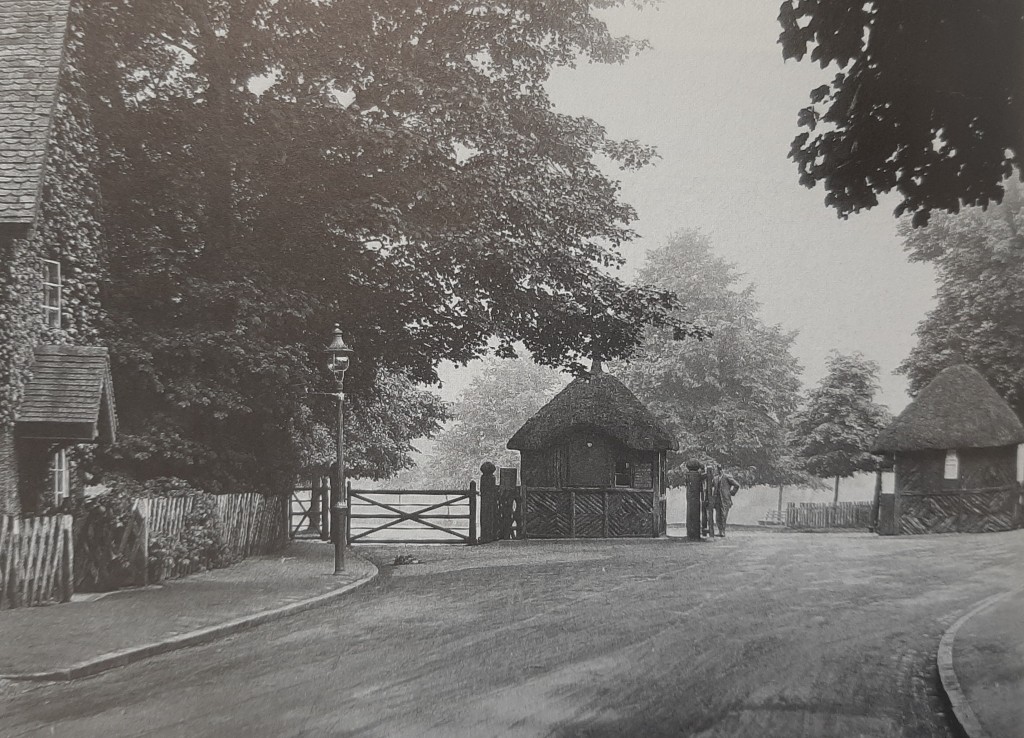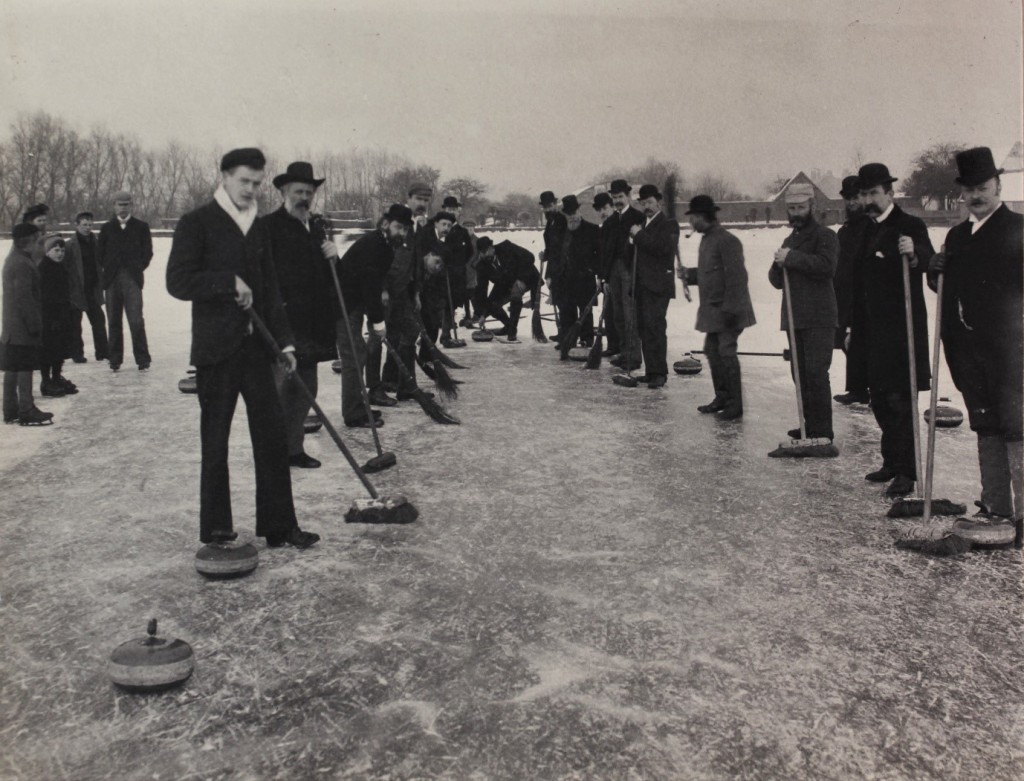A highlight of Sutton Coldfield for me is Sutton Park. Although I’ve regularly walked through the park since I moved to Sutton Coldfield 3 years ago, the park has become more important to me than ever before. It has been and is a place I can recharge, see nature and see a part of Birmingham that people may not be aware of, nor know of its importance. It is a site of special scientific interest under the Wildlife and Countryside Act of 1981 and the largest Local Authority park in the UK. While I was in the archive, I had the opportunity to look at some old photos of Sutton Park and through these photos was fascinated by how similar some things felt and how other things felt like they were from another era. I am going to (attempt to!) tell a potted history of Sutton Park from them.

Many walks start at Town Gate. See Fig 1. This is the main entrance which is probably most familiar to people today who have visited Sutton Park. Built in 1826, this gate was finally able to provide a direct approach to the park from the town. Since its creation, it does not look much different. Prior to this, the original main entrance would have been Wyndley gate via Manor Hill. Although the residents of Sutton Coldfield had free access, people outside of the area had to pay to gain admission. It was only in 1974 when Sutton Coldfield became part of Birmingham that the admission fee was abolished so it could be enjoyed by all no matter where they were from.
Once you have entered, there are around 2400 acres of park to explore. You can see some of the last surviving examples of countryside in the area. Sutton park is a remnant of an extensive forest that would have once covered the Midlands. Now the park is completely encircled by urban development which has made it a sanctuary for many kinds of plants, insects, animals and birds. Sutton Park is made up of 3 main elements, namely woodland, wetland and heathland. See Fig 2.

As you wander through the many fields in the park you might see a herd of cows. Grazing livestock have been in the park for many centuries. Then, as now, the cows graze, playing an important part in managing the park’s landscape, its ecosystem and in conserving the park. When winter comes, the cows go back to the farm where they came from and only come back to graze when the weather is warmer. See Fig 3.
As well as the cows, the park is also home to Exmoor ponies. They live there all year round, near the heathland areas of the park. The heathland is diverse, comprising dry and wet heathland areas, bog, mire and acid grassland. During the late 1970s, birch seedlings became established and grew into a birch woodland where once there was heathland. This was after a fire in the park prevented animals from grazing for a couple of years so the land could recover. In 1989, work began to restore the heathlands. Large areas of birch trees and gorse were cleared from areas that should be open heathland. The ponies help preserve the heathland by grazing on the wild birch tree shoots. Their grazing on these shoots stops the fast-growing birch becoming a birch forest with the ponies working hard to keep the invading birch trees at bay! Without them, Sutton Park would look and feel a very different place.
As you walk through the park you will encounter at least one of the pools. There are 7 in total. Although now water birds and gundogs mostly use the pools for a swim and you may see the odd small boat floating along, the history of the 7 pools tells a different story. During the late 17th and early 18th centuries Sutton Coldfield’s attempt to become industrial took place. Most of the pools in Sutton Park today were formed by damming the streams, with mills being built on them later. Their trades ranged from making buttons, leather, bayonets and blades to cotton. During this time however, industry in Birmingham and its surrounding towns was booming! Unfortunately, the water-powered industry in Sutton Coldfield found itself unable to compete and these industries became extinct by 1885. Any signs of the mills have long been demolished.
By July 1887 an outdoor swimming bath was created on Keepers Pool. This pool is one of the older pools within the park, first created in the 12th century. The original lido in the Victorian era saw unroofed wooden walls erected to protect Victorian people’s modesty. As the craze in outdoor swimming took hold, by the 1930’s, the lido received its first major reconstruction. The pool was then opened so anyone could see the bathers. See Fig 4. Cubicles were added during this time too and this was expanded in the 1960s. As well as the lido, people swam in Keeper’s pool itself. By 1979, it was illegal to swim in the pools although moves had been made to discourage people from doing this before, on health and safety grounds. Sadly, by 2004 Keeper’s Pool bath was no more. In 2003, it had suffered an arson attack and was destroyed. Since then the area has been cleared and re-landscaped, becoming a grass bank on the side of Keeper’s Pool with no evidence it had ever existed.

Deeper into the park you may come across Bracebridge Pool. Bracebridge Pool was formed around 1420 and is one of the larger pools within Sutton Park. On the edge of the pool you might see Bracebridge Cottage. Although I am not sure when it was built, it has certainly been in the park since the later part of the 19th century. Since the 1920’s the cottage has been a catering business, with many cafes and restaurants having been there since. Today the cottage has been extended and is now a restaurant called ‘The Bracebridge.’ Walkers can now have take-away sandwiches and coffees with their muddy four-legged friends, or if that does not appeal, you can sit in the outside restaurant overlooking the pool whilst eating a 3-course meal. See Fig 5.

A photo I found that I wanted to finish on was one of people curling on one of the pools in Sutton Park. Unfortunately, I am unable to identify which pool it is. Although curling is something I immediately associate with Scottish people, it is a curious image which people certainly would not be able to even contemplate doing today in Sutton Park. It offers us a glimpse into how cold it must have been for the pools to be frozen over and for it to be safe to walk on the ice and not fall through! It’s interesting to see the sort of activities people got up to for fun and that this sport did travel further south than Scotland (even if fleetingly!). It also shows how much colder winters were. Nowadays, with the average winter temperatures just above freezing in Birmingham, it wouldn’t even get cold enough for any of the pools to freeze so you could walk on them without falling through! See Fig 6.

Please feel free to share your memories or known histories about Sutton Park in the comments section below.
Lucy Angus, Conservator


Brilliant! i no longer live in Birmingham now, but i did live there for about 50 years. Old photographs of Brum are always so good to see. Thank You.
Love this. As a child we used to look for all the little bridges on our walks in the park